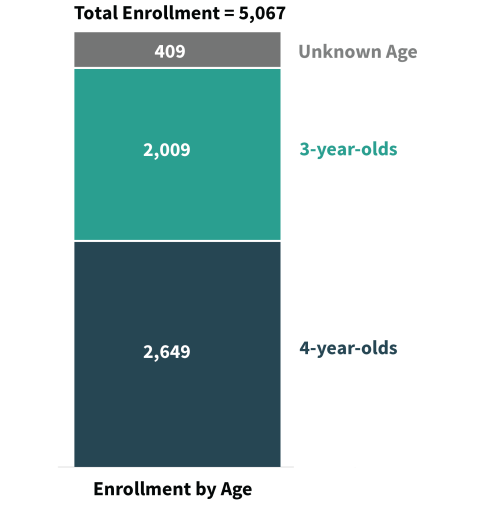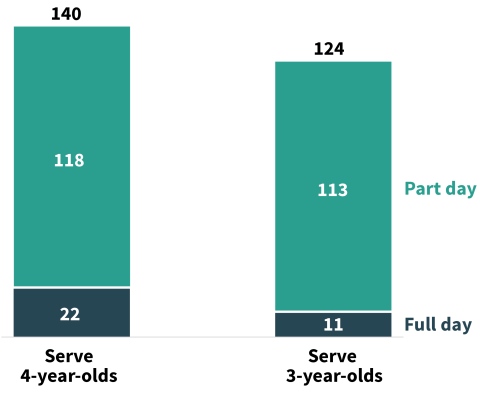Key Findings




In spring 2024, researchers at the University of New Hampshire undertook data collection to better understand the landscape of preschool offerings in New Hampshire’s public schools. School districts provide preschool using a variety of models based on local needs. All public school districts must provide access to a free appropriate public education for preschool-aged children with an identified disability under the Individuals with Disabilities Education Act (IDEA) Part B.1 Children identified under IDEA Part B have an Individualized Education Program, or IEP, to support their learning. Some districts receive Title I funding to include preschool opportunities for children who are identified as “at-risk” for learning disadvantages. Still other districts offer limited access to local children via tuition-based slots or wider community access through creative use of local taxes or grant funds.2
This brief includes data collected from all New Hampshire public schools with state-recorded preschool or kindergarten enrollment (see Data & Methods section for details). The goal was to determine the number of preschool slots offered within New Hampshire public schools and whether the school districts serve preschool-aged children with and without IEPs. The data show that programs extending beyond IDEA Part B exist. However, our data collection did not include details on how such programming was funded, nor on the number of children with and without IEPs in specific classrooms or programs.3 Thus, from this round of data collection we cannot fully identify or fully describe the reach of preschool access in New Hampshire public schools for children without an IEP specifically.
New Hampshire has 144 preschool programs in public schools, serving 3- and/or 4- year-olds to varying degrees
New Hampshire is home to 144 preschool programs in public schools. The programs provide access to a free appropriate public education in public school settings for children with IEPs. However, 129 of the 144 programs reported serving children without IEPs too, leaving 15 that reported serving only children with IEPs. Of these 15, 10 served only children with IEPs of any age. Five reported serving children with only IEPs in either their 3-year-old or 4-year-old group. Because districts are required to make special education programming available to children with an IEP, a program’s capacity to serve children without IEPs may shift as needs within the community change.4
The programs in this dataset reported 5,067 children enrolled in spring 2024; the number with and without an IEP are unknown. However, the New Hampshire Education Department recorded 2,741 children with an IEP enrolled in all preschool settings, including public schools and community-based settings.5 This suggests that, at minimum, more than 2,300 children in public school preschool settings do not have IEPs and are being served through a funding mechanism other than IDEA Part B. Overall enrollment of 5,067 suggests that about one-in-five of New Hampshire’s 25,000 3- and 4-year-olds were connected to programming at New Hampshire’s public schools.6
Schools reported their enrolled students’ ages: of the 5,067 enrolled, 52 percent were 4-year-olds, 40 percent were 3-year-olds, and 8 percent of students had no age data available (see Figure 1).7 Most programs reported serving both 3- and 4-year-olds (126 of 144), while 1 program reported serving only 3-year-olds, and 17 programs reported serving only 4-year-olds.
Preschool programs in New Hampshire schools are distributed across the state (see Map 1). These programs generally follow the population distribution, with more programs operating in the state’s southern tier.

Source: Preschool Development Grant staff data collection; figure includes information about 143 programs as one program provided no enrollment information.

Source: Preschool Development Grant staff data collection; 144 programs. Note: Orange dots mark the 10 programs that only enroll children who have an IEP. Turquoise dots mark the 5 programs that serve one age group with and without IEPs and another age group with IEPs only.
Few programs offer full-day and/or full-week programming for enrolled children
Amongst the public schools that provide preschool programming for children without IEPs, most of that programming is part-day, part-week, or both. Offerings also differ by age, with preschool programs in public schools more often offering full-day and/or full-week programming to 4-year-olds than to 3-year-olds. About one-third of 4-year-old programs are available five days per week, while fewer than one-in-five are available for full-day programming. Most of the programs that offer a full-day option also have a five-day per week option available. This includes 20 of the 22 programs serving 4-year-olds for a full day and all 11 programs serving 3-year-olds for a full day. See Figures 2 and 3.

Note: Data on length of day were not available for three 4-year-old programs and three 3-year-old programs. Programs that offer full- and part-day options are grouped with the full-day offerings here.

Note: Data on number of days offered were not available for two 4-year-old programs and two 3-year-old programs. Programs that offer a 4.5 day / week option are grouped with the 5-day offerings here.
Programs have limited capacity to serve children without an IEP
Children with an IEP under IDEA Part B receive free preschool access. However, most programs have limited capacity to serve children who do not qualify through this federal funding mechanism and must utilize a waitlist. Waitlists exist for both 3- and 4-year-olds in about three-quarters of programs.
While public school districts can utilize federal IDEA funding to support preschool access for children with an IEP or Title I funds to extend access to children in qualifying neighborhoods, no funding stream exists for supporting universal access. As a result, a common mechanism by which schools can offer programming for children who do not otherwise qualify is to charge tuition (see Box 1). Indeed, of the 131 programs that serve children without an IEP, 83 reported charging tuition, while 48 programs did not.
Filling the gaps: Building New Hampshire’s public early care and education ecosystem
Preschool programs in public schools are an important part of the state’s complex early care and education ecosystem, which ideally includes a robust set of offerings that support children’s development and family choice. But gaps in access persist for families. Many programs have waitlists and limited accessibility compared to the number of families seeking early care and education. As this brief shows, full-day, full-week preschool programming in public schools remains a rare option for New Hampshire families. Even where it exists, a school-day-length offering that is closed in the summer may not necessarily align with working families’ needs. Even the most established and robust preschool models in public schools are not an accessibility solution for every community. Rather, such programming provides one option for local families amid the state’s landscape of early care and education opportunities.
Expanding preschool programming in public schools to reach students without an IEP requires districts to identify additional funding sources. Some example approaches are described in Box 1, but it is likely that additional opportunities exist. For instance, this might include developing public-private partnerships to intentionally leverage the funding and infrastructure available through affiliation with a local education agency. Local programs could also consider ways to “braid” funding streams to expand options for families. One example of such a strategy is to utilize Child Care and Development Fund resources available to child care providers licensed under the state’s Department of Health and Human Services to provide extended hours for children enrolled in preschool programs. In each case, efforts to build programs’ public accessibility will take time. New Hampshire communities that are earlier in their preschool planning processes may find efficiencies in replicating more integrated funding models and leveraging lessons learned elsewhere.
Fully understanding what those lessons might be will require additional data. While the data here show that at least some preschool programs in public schools extend beyond special education, it does not include comprehensive information about how public schools fund and implement programming. New Hampshire’s history of “local control” allows communities to approach preschool programming in ways that respond to local needs and utilize locally available resources. However, it also means that there is no system for capturing details on the complexities of funding and program models statewide. This remains a task for future research.
Identifying individual programs’ funding mechanisms was not part of the data collection effort for this brief, in part because the complexity of the required responses might have deterred schools from participating in the basic data collection effort. Nonetheless, this project yielded some details on funding approaches through school contacts’ notes and input from expert reviewers. Here, we provide descriptive examples of funding models, leaving more systematic data collection around funding for future research.
Leveraging local funds to also serve children without identified disabilities—Both the Bartlett School District and the Jaffrey-Rindge Cooperative School District offer tuition-free, full-day preschool for 3- and 4-year-olds.9 Funded with voter-approved funds,10 each program has an enrollment cap and a waitlist.11
Tuition-based models—The Exeter School District and the Barrington School District provide free services to children with IEPs and offer tuition-based slots for children without IEPs. In Exeter, tuition is $2,000 annually;12 in Barrington, it is $245 per month ($2,450 annually).13 In the Cornish School District, children with and without IEPs are served in a half-day morning program funded by IDEA and district funds, respectively. The program continues for children with IEPs in the afternoon, and families of children without IEPs can choose to enroll their children in the “afternoon childcare program” at a rate of $20 per day.14
Expanding with Title I funds—At the time of data collection, the Nashua School District offered three preschool programs. Play Pals is open to children with and without IEPs, with tuition charged for children without an IEP ($1,800 per year).15 Purple Panthers Preschool at Nashua High School South, functions as a practicum site for high school students and is structured similarly to Play Pals. Third, Nashua has five schools in Title I neighborhoods, each of which, until the program’s recent closure, sent children to a Title I-funded preschool. In the Manchester School District, there are preschool offerings for two groups of children: “Special Education for children with identified disabilities” and “Title I for children residing in Title I school neighborhoods.”16 Title I-funded slots are limited.
Offering special education services in community-based settings—The Hooksett School District offers preschool at the elementary school to 3- and 4-year-olds with and without IEPs. In addition, the district provides IDEA funding and on-site special education services to about 10 community child care centers that enroll children with IEPs.17 This aligns with the aim of serving children with disabilities in the “least restrictive environment.”18
Data
Data were collected between January and March 2024, and represent enrollment for the 2023–2024 school year. The data collection approach was developed by identifying all public schools in the New Hampshire Department of Education’s “Public School Enrollments by Grade” data that recorded any students enrolled in preschool or kindergarten in the fall. Sites included both public schools and standalone preschool sites that are part of a school district.
Along with programs reporting preschool enrollment, we also included kindergarten-offering sites without reported preschool enrollment under two assumptions. First, schools may not use a consistent set of definitions when reporting preschool enrollment information to the state, a challenge that could be ameliorated by collecting information from all potential sites using a single tool. Second, with a rapidly evolving preschool landscape, sites might have new information since the state enrollment records were collected for fall 2023. The initial outreach list included 265 potential preschool sites; all sites were successfully contacted by phone or email regarding program information. One site did not offer preschool directly but referred us to a location where public preschool was offered for the district. As such, the resulting dataset included 266 potential preschool sites, 144 of which were found to offer preschool. One site acknowledged the presence of a preschool program but did not provide any enrollment data. Thus, data on enrollment includes 143 of the 144 programs.
Endnotes
- According to the NH Department of Education, “New Hampshire is committed to providing a free, appropriate public education (FAPE) for children ages 3–5 with disabilities. By federal and state law, local school districts must work with families and community partners to identify and serve children who are eligible for special education and related services and ensure that services begin by the child’s third birthday through age 22. An Individualized Education Program (IEP) is developed for each eligible child based on that child’s strengths and needs. Placements are based on the Least Restrictive Environment (LRE) and may include a public preschool/kindergarten, Head Start program, or the child’s home. Sometimes, the placement is in a separate approved special education program or residential facility. For more: New Hampshire Department of Education. Preschool Special Education. https://www.education.nh.gov/who-we-are/division-of-learner-support/bureau-of-student-support/special-education/preschool
- For example, the Jaffrey-Rindge Cooperative School District utilized the third round of funding from American Rescue Plan Act’s Elementary and Secondary School Emergency Relief Fund (ESSER III) to expand its preschool programming (author communication with the superintendent of SAU 47 via email 7/26/24). For more about ESSER III: New Hampshire Department of Education. American Rescue Plan Act—Elementary and Secondary School Emergency Relief Fund | Department of Education. https://www.education.nh.gov/who-we-are/division-of-learner-support/bur…
- For more information on types of preschool program classrooms: The Parent Information Center. Examining Where Services to Children with Disabilities Are Provided. Race 2K https://race2k.org/environmentssettings/
- Although 15 schools indicated that they only served children with IEPs in their 3-year-old programming, 4-year-old programming, or both, it is unclear the extent to which this is due to policy or limited capacity. It is possible that at least some of these schools would serve children without an IEP if preschool special education needs shifted.
- Author communication with the New Hampshire Department of Education, Office of Special Education Training and Monitoring, via email 7/24/24.
- U.S. Census Bureau. Population and Housing Unit Estimates, 2023. Census.Gov. https://www.census.gov/popest
- One school did not report enrollment numbers, and thus are included in the count of programs but excluded from counts of enrollment.
- Programs that offer a 4.5 day / week option are grouped with the 5-day offerings here. This includes 8 programs serving 4-year-olds and 1 program serving 3-year-olds.
- Josiah Bartlett Elementary School. Parent/Student Handbook: 2023–2024 School Year. https://drive.google.com/file/d/1dz-P7aDPF36Vcset5qX0x6ymA866E2-a/view; Jaffrey-Rindge School District. Preschool Information. https://forms.piftech.com/frevvo/web/tn/sau47.org/u/86ec5d37-d1ba-4a73-b22d-b9fb43505eec/app/_YeD9gIy7EeuOxoEot4BaIg/flowtype/_6ZwR4JRTEe6Rz502rjfz3A/popupform?_formTz=America%252FNew_York
- For Bartlett: Jones, L. 2018. Bartlett overwhelmingly passes integrated preschool. The Conway Daily Sun. https://www.conwaydailysun.com/news/local/bartlett-overwhelmingly-passes-integrated-preschool/article_bc7b01da-2244-11e8-8a2f-ef5c03cf8cb0.html; for Jaffrey-Rindge: McIntyre, M. 2020. What NH can learn about publicly funded pre-K. Concord Monitor. https://www.concordmonitor.com//Chasing-universal--What-NH-can-learn-about-publicly-funded-pre-K-37889199
- Enrollment cap info from Student Family Handbook and Preschool Information Page; waitlist information from authors’ data collection.
- Exeter Developmental Preschool. https://edp.sau16.org/en-US
- Early Childhood Learning Center. SAU 74 Preschool Program. https://eclc.sau74.org/for_parents/preschool
- Cornish Elementary School. 2024. Cornish Elementary School Handbook for Pre-Kindergarten and Afternoon Child Care 2024–2025. https://docs.google.com/document/d/1PU-37Kh6sAyOtEmclYc7gyACInEw-WEt-lh17nbPTPM/edit#heading=h.4d34og8
- Nashua School District. NEEP - Nashua Early Education Program—Playpals. https://www.nashua.edu/Page/1570
- Manchester School District. 2024. Selma Deitch Early Learning Program. https://www.mansd.org/page/preschool
- Information about the Hooksett School District was volunteered by the Early Learning Program contact through the course of this paper’s data collection.
- The Parent Information Center. Examining Where Services to Children with Disabilities Are Provided. Race 2K https://race2k.org/environmentssettings/
About the Authors
- Eileen Murphy is the Project Coordinator of the New Hampshire Preschool Development Grant at the University of New Hampshire.
- Tyrus Parker is a Research Scientist II at the Center for Social Policy in Practice at the Carsey School of Public Policy.
- Carrie Portrie is a program manager for New Hampshire Listens and a research assistant professor at the Carsey School of Public Policy.
- Jess Carson is the director of the Center for Social Policy in Practice and a research assistant professor at the Carsey School of Public Policy.
Acknowledgements
This project was supported in part by New Hampshire’s Preschool Development Grant (PDG), sponsored by the Administration for Children and Families (Award# 90TP0110). Any opinions, findings, conclusions, or recommendations expressed in this presentation do not necessarily reflect the views of any organization or agency that provided support for the project. Additional project support from the Couch Family Foundation has made this work possible.
The authors are grateful to Michael Bennett and Sara Vecchiotti at the Couch Family Foundation, Christina D’Allesandro at the New Hampshire Charitable Foundation, Nicole Heller at the New Hampshire Fiscal Policy Institute, Michelle Lewis at the Parent Information Center, and the Preschool Development Grant Leadership team for their reviews of earlier drafts. The authors also appreciate Carsey School colleagues’ support, including Laurel Lloyd’s editing and layout expertise, and Erin Knapp’s research assistance. Special thanks to the New Hampshire Department of Education, including Deputy Commissioner of Education Christine Brennan, Krisha Dubreuil in the Office of Special Programs, and Alexa Simmons in the Office of Special Education Training and Monitoring for their patient provision of feedback and data.
© 2024. University of New Hampshire. All rights reserved.
